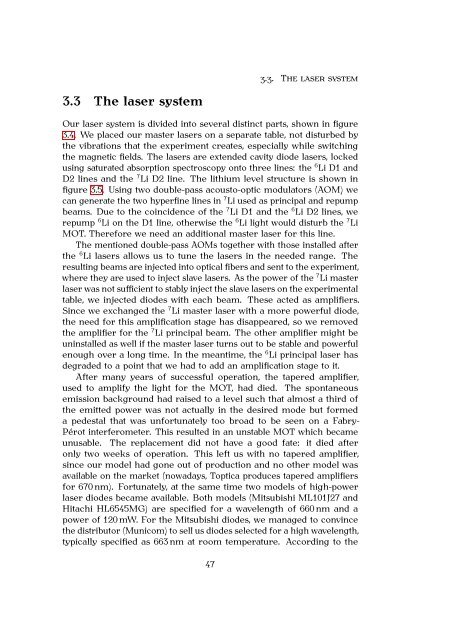Martin Teichmann Atomes de lithium-6 ultra froids dans la ... - TEL
Martin Teichmann Atomes de lithium-6 ultra froids dans la ... - TEL
Martin Teichmann Atomes de lithium-6 ultra froids dans la ... - TEL
You also want an ePaper? Increase the reach of your titles
YUMPU automatically turns print PDFs into web optimized ePapers that Google loves.
3.3 The <strong>la</strong>ser system<br />
3.3. THE LASER SYSTEM<br />
Our <strong>la</strong>ser system is divi<strong>de</strong>d into several distinct parts, shown in figure<br />
3.4. We p<strong>la</strong>ced our master <strong>la</strong>sers on a separate table, not disturbed by<br />
the vibrations that the experiment creates, especially while switching<br />
the magnetic fields. The <strong>la</strong>sers are exten<strong>de</strong>d cavity dio<strong>de</strong> <strong>la</strong>sers, locked<br />
using saturated absorption spectroscopy onto three lines: the 6 Li D1 and<br />
D2 lines and the 7 Li D2 line. The <strong>lithium</strong> level structure is shown in<br />
figure 3.5. Using two double-pass acousto-optic modu<strong>la</strong>tors (AOM) we<br />
can generate the two hyperfine lines in 7 Li used as principal and repump<br />
beams. Due to the coinci<strong>de</strong>nce of the 7 Li D1 and the 6 Li D2 lines, we<br />
repump 6 Li on the D1 line, otherwise the 6 Li light would disturb the 7 Li<br />
MOT. Therefore we need an additional master <strong>la</strong>ser for this line.<br />
The mentioned double-pass AOMs together with those installed after<br />
the 6 Li <strong>la</strong>sers allows us to tune the <strong>la</strong>sers in the nee<strong>de</strong>d range. The<br />
resulting beams are injected into optical fibers and sent to the experiment,<br />
where they are used to inject s<strong>la</strong>ve <strong>la</strong>sers. As the power of the 7 Li master<br />
<strong>la</strong>ser was not sufficient to stably inject the s<strong>la</strong>ve <strong>la</strong>sers on the experimental<br />
table, we injected dio<strong>de</strong>s with each beam. These acted as amplifiers.<br />
Since we exchanged the 7 Li master <strong>la</strong>ser with a more powerful dio<strong>de</strong>,<br />
the need for this amplification stage has disappeared, so we removed<br />
the amplifier for the 7 Li principal beam. The other amplifier might be<br />
uninstalled as well if the master <strong>la</strong>ser turns out to be stable and powerful<br />
enough over a long time. In the meantime, the 6 Li principal <strong>la</strong>ser has<br />
<strong>de</strong>gra<strong>de</strong>d to a point that we had to add an amplification stage to it.<br />
After many years of successful operation, the tapered amplifier,<br />
used to amplify the light for the MOT, had died. The spontaneous<br />
emission background had raised to a level such that almost a third of<br />
the emitted power was not actually in the <strong>de</strong>sired mo<strong>de</strong> but formed<br />
a pe<strong>de</strong>stal that was unfortunately too broad to be seen on a Fabry-<br />
Pérot interferometer. This resulted in an unstable MOT which became<br />
unusable. The rep<strong>la</strong>cement did not have a good fate: it died after<br />
only two weeks of operation. This left us with no tapered amplifier,<br />
since our mo<strong>de</strong>l had gone out of production and no other mo<strong>de</strong>l was<br />
avai<strong>la</strong>ble on the market (nowadays, Toptica produces tapered amplifiers<br />
for 670 nm). Fortunately, at the same time two mo<strong>de</strong>ls of high-power<br />
<strong>la</strong>ser dio<strong>de</strong>s became avai<strong>la</strong>ble. Both mo<strong>de</strong>ls (Mitsubishi ML101J27 and<br />
Hitachi HL6545MG) are specified for a wavelength of 660 nm and a<br />
power of 120 mW. For the Mitsubishi dio<strong>de</strong>s, we managed to convince<br />
the distributor (Municom) to sell us dio<strong>de</strong>s selected for a high wavelength,<br />
typically specified as 663 nm at room temperature. According to the<br />
47

















